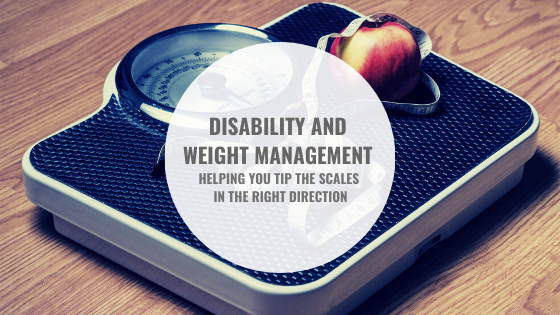Julie Entwistle, C.Dir. (c), MBA, BHSc (OT), BSc (Health / Gerontology)
I find that while many of my clients initially lose weight following trauma (hospital food diet); eventually the net impact of a disability is often weight gain. This is often the result of many factors – most interacting to make the solution difficult to isolate. Medication side-effects, altered routines, reactive eating, friends and family that provide unhealthy sympathy foods, increased use of fast food because preparing meals is difficult, inactivity, depression, and even hormonal and physiological changes to the body as a result of the trauma.
But we do know that 70% of weight management is diet and assuming this is true, then the solution to weight management should be simple – you can’t eat it if you don’t buy it. Purchasing unhealthy food is the first step to a weight problem. And weight problems in disabled people are exponential. Everything becomes harder – transfers, walking, completion of daily tasks, caregiving, and many pieces of equipment have weight limits that when exceeded result in equipment failure.
What is even more problematic is the role of the caregiver in the maintenance of weight in the person they are caring for. When people cannot shop for food and cannot cook, then helping them to maintain weight becomes the job of the caregiver. Just buy and prepare healthy foods – perhaps food prescribed by a nutritionist or dietician. However, often caregivers rely on the disabled person to dictate the food choices but if people are emotionally eating, or eating out of boredom, then the caregiver cannot always rely on the individual to make the best decisions. Often raising awareness about healthy eating starts with asking people to track what and when they are eating and drinking. Then, problems can be identified, and a list of doable solutions can be developed.
In one instance, in helping a client with weight loss as a functional goal, we discovered through tracking that she was barely eating breakfast and lunch but was consuming all of her calories from 5-10 pm. We made the goal that, over time, she would consume breakfast, lunch, two snacks and dinner, and would stop eating after 7 pm. Within a few short months, she lost 30 pounds, and this greatly improved her mobility and tolerances for activity. Another client discovered through tracking that he was consuming far too many large bottles of pop a day. By changing his large bottle to a smaller one, and eventually to only one pop per day and the rest water, he was able to drop 20 pounds. In both cases, the problems, solutions, and commitment to change were made by my clients (with my guidance and support), making the results far more meaningful and lasting. Further, the client was shown a framework for how to check and modify eating habits should they deteriorate again in the future.

